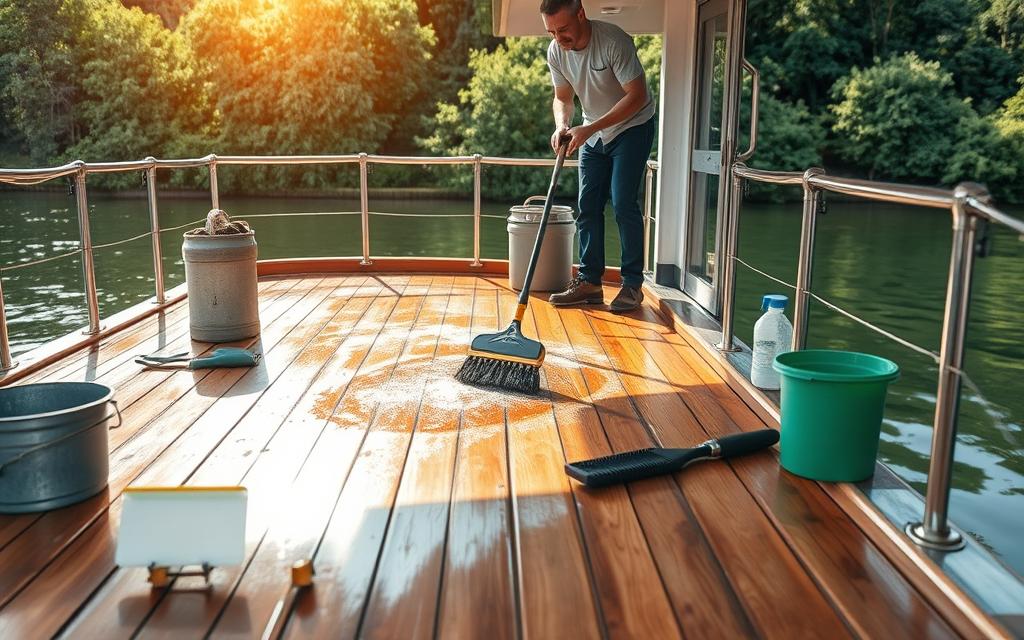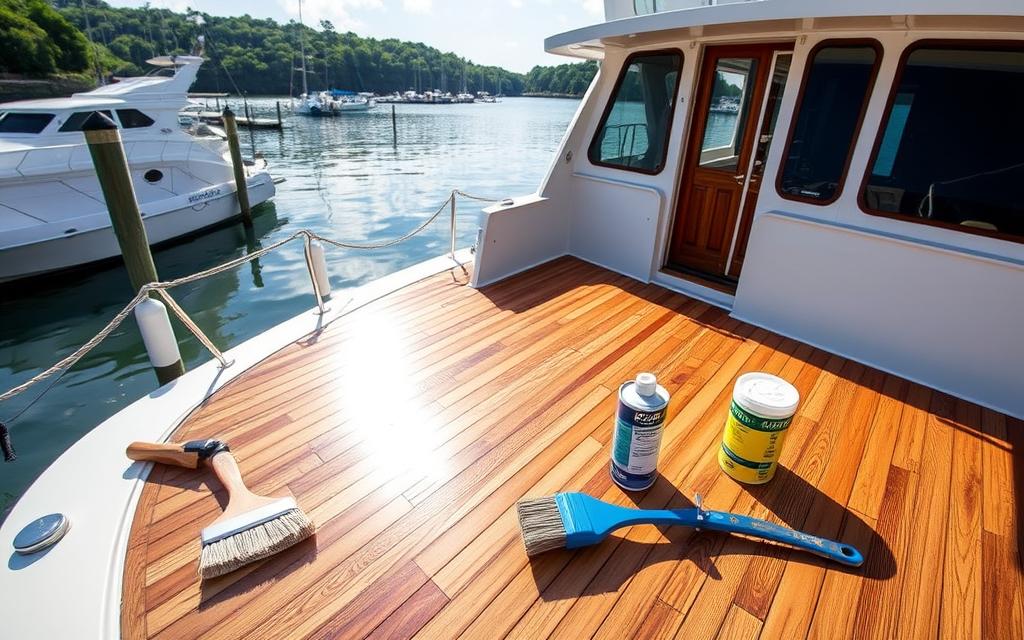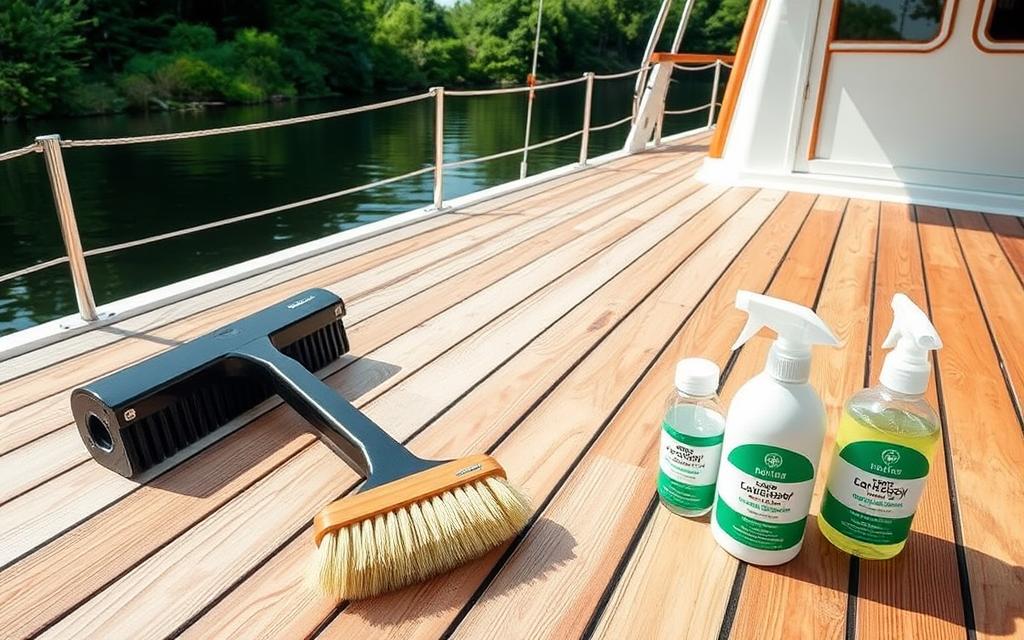Table of Contents
Ever wonder how to maintain houseboat deck and exterior surfaces to stand out? Yes, it’s all about the upkeep. Knowing how to care for your houseboat is key to keeping it in top shape.

As a houseboat owner, I’ve learned that deck and exterior care is more than looks. It’s about keeping your investment safe. Regular maintenance saves you money and keeps your home on the water looking great.
In this guide, I’ll share tips on keeping your houseboat’s deck and exterior in top shape. We’ll cover everything from cleaning to advanced protection. These methods will help you keep your houseboat looking new, whether you’re new to houseboats or a seasoned sailor.
Key Takeaways
- Regular maintenance prevents expensive long-term damage
- Cleaning and inspection are critical for houseboat longevity
- Different surfaces require specialized care techniques
- Protective coatings extend your houseboat’s lifespan
- Seasonal maintenance is key for the best performance
Understanding the Importance of Deck Maintenance
Deck maintenance is key to protecting your houseboat. It’s not just about looks; it’s about keeping your boat safe and running well. Good care can save you a lot of money and keep your home on the water in great shape.
Here’s why keeping up with deck care is essential for houseboat owners:
- Prevents structural degradation
- Maintains aesthetic appeal
- Ensures passenger safety
- Protects against environmental damage
Why Regular Maintenance Matters
Regular maintenance is more than just keeping your boat looking good. It’s about protecting your investment. Regular care helps spot problems early, saving you money in the long run.
“An ounce of prevention is worth a pound of cure” – This classic saying perfectly describes marine surface protection strategies.
Potential Issues from Neglect
Ignoring your houseboat’s deck can cause big problems. Issues like water damage, wood rot, and weakening the structure are just a few risks. Here are some problems you might face:
- Structural integrity compromise
- Increased repair costs
- Reduced resale value
- Safety hazards for passengers
Knowing these risks helps you take a proactive approach to deck maintenance. This way, you can protect your investment and enjoy safe, happy years on the water.
Choosing the Right Cleaning Products
Keeping your houseboat’s exterior in top shape is all about picking the right cleaning products. These products should protect your boat and the environment. It’s not just about cleaning; it’s about using the best tools and solutions to keep your boat looking great.
When picking cleaning solutions for your houseboat, there are a few important things to keep in mind. This ensures your boat’s surfaces look their best.
Eco-Friendly Cleaning Options
It’s vital to protect marine ecosystems when cleaning your houseboat. Look for products that are biodegradable and have a low environmental impact:
- Phosphate-free marine cleaners
- Plant-based detergents
- Concentrated solutions to reduce plastic waste
Recommended Brands for Marine Canvas Cleaning
For cleaning marine canvas, I recommend these specialized products:
- Star brite Marine Canvas Cleaner
- Meguiar’s Marine Vinyl & Canvas Cleaner
- 303 Fabric Guard for marine textiles
“The right cleaning product can extend the life of your houseboat’s exterior surfaces and maintain their pristine appearance.”
Pro tip: Always test cleaning products on a small, inconspicuous area first to ensure compatibility with your specific houseboat materials.
| Surface Type | Recommended Product Characteristics |
|---|---|
| Marine Canvas | UV-resistant, mildew-preventing formulas |
| Fiberglass Exterior | Non-abrasive, oxidation-removing cleaners |
| Wooden Surfaces | pH-neutral, wood-specific marine cleaners |
Cleaning Your Deck: Step-by-Step Process
Keeping your boat deck in top shape is key to its beauty and life span. A clean deck not only looks good but also shields your boat from harm. Here’s how to clean your deck the right way.
Essential Materials for Deck Cleaning
First, get these important items ready for cleaning:
- Soft-bristled scrub brush
- Non-abrasive cleaning solution
- Bucket of clean water
- Microfiber cloths
- Protective gloves
- Deck-specific cleaning solution
Detailed Cleaning Technique
Here’s how to clean your deck effectively:
- Take off all furniture and loose items from the deck
- Wash the whole area with fresh water
- Put on marine cleaning solution
- Scrub gently in circles
- Wash off with clean water
- Use microfiber cloths to dry it completely
“A clean deck is the foundation of a well-maintained houseboat” – Professional Marine Maintenance Expert
Pro tip: Always test cleaning products on a small, hidden spot first. This makes sure they won’t harm your deck material.
Special Considerations
Different deck materials need special care. Wooden decks are more delicate than fiberglass or composite ones. Be extra careful in areas that get a lot of foot traffic or where moisture might collect.
By using these tips, you’ll keep your boat deck looking great and extend its life.
The Role of Sealing in Deck Maintenance
Keeping your houseboat’s deck safe from damage is key. Sealing is a vital step to protect your vessel’s exterior. It keeps your deck looking great and lasting longer.

Sealing does more than just look good. It stops water damage, UV rays, and other harm. This helps keep your teak decking in top shape.
Types of Sealants for Marine Environments
Choosing the right sealant is important. Each material needs its own protection:
- Marine-grade polyurethane sealants
- Epoxy-based protective coatings
- Silicone-based waterproof sealants
- Specialized teak deck treatments
Proper Sealant Application Techniques
Follow a careful process for the best results:
- Clean the surface well
- Sand rough spots
- Get rid of dust and dirt
- Apply sealant in thin layers
- Wait for each layer to dry
| Sealant Type | Best Used For | Durability |
|---|---|---|
| Polyurethane | Wooden Decks | 5-7 Years |
| Epoxy | Fiberglass Surfaces | 8-10 Years |
| Silicone | Seam Sealing | 3-5 Years |
“Proper sealing is the difference between a deck that survives and one that thrives” – Marine Maintenance Experts
Pro tip: Always test sealants in a small, inconspicuous area before full application to ensure compatibility with your specific deck material.
Inspecting Your Deck for Damage
Maintaining your houseboat means keeping an eye on your deck. This helps avoid expensive fixes and keeps everyone safe. Knowing how to spot problems early is key to good boat care.
Regular checks are vital for your houseboat’s health. As someone who’s owned a houseboat for a while, I’ve seen how catching issues early saves a lot of money and time.
Critical Signs of Wear and Tear
- Visible surface cracks or splits in deck materials
- Discoloration or fading of protective coatings
- Soft or spongy areas indicating water damage
- Loose or corroded fittings and hardware
- Signs of wood rot or material degradation
Comprehensive Inspection Techniques
Here’s how to do a detailed deck check:
- Start with a quick look over the whole deck
- Look for any structural oddities
- Test how solid the deck feels by walking on it
- Check seams and connections closely
- Use good lighting to spot hidden damage
“Prevention is always cheaper than repair in houseboat maintenance.” – Professional Marine Technician
Spending time on regular checks can save you a lot. It keeps your houseboat safe and looking great for many years.
Repairing Damaged Deck Surfaces
Keeping your houseboat’s deck in good shape is key. It’s not just about cleaning. You also need to fix small problems before they get big. If you don’t, they could harm your boat’s safety and look.
DIY Solutions for Minor Repairs
For small deck issues, you can try some DIY fixes. Here are a few tips:
- Check the damage first
- Clean the area well for better sticking
- Apply marine-grade epoxy for small cracks
- Smooth out the fixed area with sandpaper
Fixing fiberglass gel coat needs special care. I suggest using a marine-grade gel coat repair kit. These kits usually have:
- Repair compounds
- Different grit sandpaper
- Protective coatings
- Clear instructions
When to Call a Professional
Some repairs are too hard for DIY. You should call a pro for:
- Big structural damage
- Large areas of delamination
- Waterproofing issues
- Complex fiberglass gel coat fixes
“A small repair today can prevent a costly replacement tomorrow.”
Marine experts have the right tools and know-how. They can spot problems you might miss.
Protecting Against Sun Damage
Sunlight can be a big problem for houseboats, causing a lot of damage. As a houseboat owner, it’s important to protect your boat’s exterior. This helps keep your boat looking good and its value high.
Sun damage can quickly ruin your houseboat’s deck and outside surfaces. UV rays can make materials fade, crack, and weaken. Using the right maintenance tips can help prevent this.
UV Protective Coatings
Choosing the right protective coating is key for keeping your boat safe. Here are some good options:
- Ceramic-based UV sealants
- Marine-grade polymer coatings
- Specialized UV-resistant clear polymers
Strategies for Shade and Coverage
Creating shade can help block sunlight. Here are some ways to do it:
- Install retractable awnings
- Use marine-grade shade sails
- Design removable canvas covers
“Protecting your houseboat from sun damage is not just maintenance—it’s an investment in your floating home’s longevity.” – Maritime Preservation Expert
Using these protection methods will keep your houseboat looking great and strong. This way, you can enjoy it on the water for many years.
Maintaining Other Exterior Surfaces
Caring for your houseboat is more than just deck maintenance. The exterior surfaces are key to keeping your boat looking good and working well. It’s important to take care of the boat hull and clean the exterior to protect your investment.
Cleaning Railing and Handrails
Railings and handrails face tough marine conditions. Each material needs its own cleaning method:
- Stainless Steel: Use a specialized marine cleaner and microfiber cloth
- Aluminum: Soft-bristled brush with mild detergent solution
- Wooden Railings: Gentle wood cleaner and protective sealant
Caring for the Hull
Boat hull care is more than just washing. It needs special attention to avoid damage and keep it running well.
| Hull Material | Cleaning Method | Frequency |
|---|---|---|
| Fiberglass | Marine-grade cleaner, wax protection | Every 3-4 months |
| Aluminum | Specialized aluminum cleaner | Quarterly |
| Wood | Specialized wood treatment | Bi-annually |
Remember, consistent houseboat exterior cleaning prevents long-term damage and maintains your vessel’s value.
Make a regular maintenance plan to protect your houseboat’s exterior. Focus on areas that get algae and barnacles, as they can harm your boat.
- Inspect hull monthly
- Remove marine growth promptly
- Apply protective coatings
By following these boat hull care tips, your houseboat will stay in top shape.
Seasonal Deck Maintenance Checklist
Keeping your houseboat’s deck and exterior in top shape changes with the seasons. Following the right houseboat maintenance tips can protect your investment. It ensures your boat stays in great condition all year.
Seasonal upkeep is key to keeping your houseboat looking and working well. I’ll show you the important tasks to keep your deck looking new and working right.
Spring Cleaning Tasks
Spring is the best time to refresh your houseboat after winter. Here are the main maintenance steps for your deck and exterior:
- Thoroughly wash the entire deck with marine-grade cleaning solution
- Inspect for winter damage and any repair needs
- Check and replace worn sealants
- Examine hardware and fittings for corrosion
Winter Preparation Steps
It’s vital to protect your houseboat from cold damage to keep its value. Here are important winter maintenance tips:
| Preparation Area | Recommended Actions |
|---|---|
| Deck Protection | Apply winter-grade protective coating |
| Water Systems | Drain and winterize all water lines |
| Exterior Surfaces | Install weatherproof covers |
“Preventative maintenance is the key to long-lasting houseboat enjoyment.” – Marina Maintenance Experts
Pro tip: Make a seasonal maintenance calendar to keep track of your houseboat’s care. Regular upkeep prevents expensive repairs and keeps your boat in great shape for longer.
Addressing Mold and Mildew
Mold and mildew are big problems for houseboat owners, thanks to the damp marine air. Keeping your boat’s exterior looking good needs careful cleaning and quick action.

Early Detection Techniques
Finding mold and mildew early is key for keeping your boat in top shape. Watch out for these signs:
- Discolored patches on surfaces
- Musty odors
- Soft or deteriorating material textures
- Dark or greenish-black spots
Effective Removal Methods
Here’s how to tackle mold and mildew on your boat’s exterior:
- Use specialized marine cleaning solutions
- Apply eco-friendly antifungal treatments
- Scrub with soft-bristled brushes
- Rinse thoroughly with fresh water
| Surface Type | Recommended Cleaning Method | Frequency |
|---|---|---|
| Marine Canvas | Mild detergent solution | Every 2-3 months |
| Fiberglass Deck | Specialized marine cleaner | Monthly |
| Wooden Surfaces | Vinegar-based solution | Quarterly |
“Prevention is always better than cure when battling mold on marine surfaces.” – Professional Marine Maintenance Expert
Pro tip: Keep your houseboat well-ventilated and use dehumidifiers to minimize moisture buildup, which prevents mold growth.
Enhancing Aesthetics with Accessories
Creating a stunning deck on your houseboat is more than just basic upkeep. Thoughtful accessories and decor can turn your outdoor space into a beautiful, welcoming area. It shows off your personal style and can handle marine conditions.
Selecting Durable Outdoor Furniture
When picking furniture for your houseboat deck, durability is essential. I suggest choosing materials made for marine environments:
- Marine-grade stainless steel frames
- Synthetic woven materials
- Teak wood with protective sealants
- Powder-coated aluminum
Decor Tips for a Cozy Nautical Atmosphere
To keep your houseboat’s deck stylish, consider these design tips:
| Decor Element | Recommended Options |
|---|---|
| Cushions | Waterproof, UV-resistant fabrics |
| Lighting | Solar-powered marine lanterns |
| Accessories | Nautical-themed throw pillows |
“A well-designed deck transforms your houseboat from a simple vessel to a true floating home.”
By choosing accessories that match your houseboat’s unique look, you’ll make an inviting outdoor space. It’s a mix of practicality and personal style.
Keeping Your Deck Safe and Slip-Free
Boat deck maintenance is more than just cleaning. Safety is key when you’re on the water. Creating a safe space needs careful planning and regular checks. Preventing slips and protecting marine surfaces can lower accidents and extend your deck’s life.
Start rust prevention with top-notch non-slip coatings for boats. These products make the surface rougher, helping you grip better, even when it’s wet. Choose marine-grade anti-slip treatments that last against harsh water and protect against accidents.
Safety Products and Coatings
Choose durable safety products that resist wear and corrosion. Look for non-slip deck treatments from brands like Interlux or Petit. These not only make your deck safer but also protect it from UV damage and structural issues. Applying these products right can make your deck safer and more durable.
Regular Safety Checks to Implement
Do monthly checks on handrails and look for loose parts. Make sure water drains properly. Walk your deck to find weak spots or slippery areas. Focus on busy spots and areas near water. Regular checks help catch problems before they become big safety issues.
FAQ
How often should I clean my houseboat’s deck?
Clean your houseboat’s deck at least every three months. Clean more often if you use it a lot. If it’s in saltwater, clean it every month to stop salt damage.
Regular cleaning keeps the deck looking good and prevents damage from dirt and salt.
What are the best cleaning products for a houseboat deck?
Use marine-specific cleaners that are good for the environment and safe for different surfaces. Look for products from Star brite, 3M Marine, and Meguiar’s Marine. Make sure they’re biodegradable and fit your deck material.
How can I prevent slip hazards on my houseboat deck?
Apply non-skid coatings or use anti-slip treatments on your deck. Products like Interlux Interdeck or grip tape can make it safer. Clean the deck often to remove algae and moss.
Adding textured mats in busy areas can also help prevent slips.
What’s the best way to protect my deck from sun damage?
Use UV-protective sealants and waxes made for marine surfaces. Get high-quality canvas covers or awnings for shade. Apply UV protectants often and use covers when not in use to avoid sun damage.
How do I deal with mold and mildew on my houseboat?
Use marine mold and mildew removers like Star brite Mold & Mildew Stain Remover. Make sure it’s well-ventilated and use products that absorb moisture. Clean often and fix moisture problems fast.
Use treatments that stop fungal growth to prevent mold and mildew.
How often should I inspect my houseboat’s deck for damage?
Check your deck at least twice a year, before and after boating season. Look for cracks, soft spots, and discoloration. In busy or harsh areas, check more often to catch problems early.
What’s the best way to seal and protect my houseboat deck?
Use marine-grade sealants for your deck type. For fiberglass, use gel coat products. For wood, use teak sealers. Prepare the surface well, apply evenly, and follow the instructions for drying time.
How can I protect metal components from rust?
Use marine-grade rust inhibitors and coatings. Clean metal surfaces often and apply anti-corrosion sprays. Consider using sacrificial anodes. Stainless steel needs cleaning and passivation to prevent rust.



